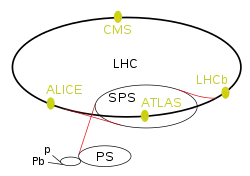سیملوله فشرده میونی
سیملوله فشرده میون (به انگلیسی: Compact Muon Solenoid، مخفف:CMS) سیملولهای است به طول ۲۱ و قطر ۱۵ متر که وزن آن حدود ۱۴۰۰۰ تن است.[1] این سیملوله یکی از دو آزمایش با اهداف عمومی در موضوع فیزیک ذرات است که برای برخورد پروتون-پروتون در برخورددهنده هادرونی بزرگ در سرن (مرز سوئیس و فرانسه) ساخته شدهاست. برای ساخت این آشکارساز تقریباً ۴۰۰۰ نفر به نمایندگی از ۲۰۶ مؤسسه علمی از ۴۷ کشور جهان مشارکت داشتند که علاوه بر ساخت این سیملوله، هماکنون در حال اداره آن هستند.[2] از اهداف آن میتوان به کشف بوزون هیگز (ذره خدا) و برخورد یونهای سنگین اشاره کرد.
 نقشه آشکارسازها و تونلها | |
| آزمایشهای LHC | |
|---|---|
| ATLAS | A Toroidal LHC Apparatus |
| CMS | سیملوله فشرده میونی |
| الاچسیبی | الاچسی-بیوتی |
| ALICE | یک آزمایش برخورددهنده بزرگ یون |
| توتم (آزمایش) | Total Cross Section, Elastic Scattering and Diffraction Dissociation |
| الاچسیاف | الاچسی-فوروارد |
| پیششتابدهندههای الاچسی | |
| پروتون و سرب | شتابدهنده خطی برای پروتونها (لیناک ۲) و سرب (لیناک ۳) |
| (not marked) | Proton Synchrotron Booster |
| PS | سنکروترون پروتون |
| SPS | ابرسنکروترون پروتون |
مکان استقرار سیملوله فشرده میونی در غاری واقع در سزی کشور فرانسه است که دقیقاً به محاذات مرز ژنو میباشد. در ژوئیه ۲۰۱۲ اعلام شد که آشکارساز اطلس به اتفاق سیملوله فشرده میونی موفق به کشف ذره خدا شدند.[3][4][5] به دنبال این موضوع و پس از بررسی بیشتر، ادعای مطرحشده تأیید شد.[6]
از اکتبر سال ۲۰۱۱ که پروژه تواترون آزمایشگاه فرمی به بنبست رسید، سیملوله فشرده میونی دیدگاههای قابلتوجهی را در رابطه با مدل استاندارد (ذرات بنیادی) فیزیک و آزمایش دقیق آنها ارائه نمودهاست. یک دستاورد عمده و اصلی این پروژه، کشف ذرهای سازگار با مدل استاندارد بوزون هیگز بود، ذرهای که از سازوکار هیگز حاصل میشود و توضیحی برای تودههای ذرات بنیادی است.[7]
نگارخانه
 تصویر سیاماس
تصویر سیاماس

منابع
- "Archived copy" (PDF). Archived from the original (PDF) on 2014-10-18. Retrieved 2014-10-18.
- "CMS Collaboration - CMS Experiment". cms.cern. Retrieved 28 January 2020.
- Biever, C. (6 July 2012). "It's a boson! But we need to know if it's the Higgs". New Scientist. Retrieved 2013-01-09.
'As a layman, I would say, I think we have it,' said Rolf-Dieter Heuer, director general of CERN at Wednesday's seminar announcing the results of the search for the Higgs boson. But when pressed by journalists afterwards on what exactly 'it' was, things got more complicated. 'We have discovered a boson – now we have to find out what boson it is'
Q: 'If we don't know the new particle is a Higgs, what do we know about it?' We know it is some kind of boson, says Vivek Sharma of CMS [...]
Q: 'are the CERN scientists just being too cautious? What would be enough evidence to call it a Higgs boson?' As there could be many different kinds of Higgs bosons, there's no straight answer.
[emphasis in original] - Siegfried, T. (20 July 2012). "Higgs Hysteria". Science News. Retrieved 2012-12-09.
In terms usually reserved for athletic achievements, news reports described the finding as a monumental milestone in the history of science.
- Del Rosso, A. (19 November 2012). "Higgs: The beginning of the exploration". CERN Bulletin. Retrieved 2013-01-09.
Even in the most specialized circles, the new particle discovered in July is not yet being called the “Higgs boson". Physicists still hesitate to call it that before they have determined that its properties fit with those the Higgs theory predicts the Higgs boson has.
- O'Luanaigh, C. (14 March 2013). "New results indicate that new particle is a Higgs boson". CERN. Retrieved 2013-10-09.
- "The Higgs Boson". CERN: Accelerating Science. CERN. Retrieved 11 June 2015.
جستارهای وابسته
- Della Negra, Michel; Petrilli, Achille; Herve, Alain; Foa, Lorenzo; (2006). "CMS Physics Technical Design Report Volume I: Software and Detector Performance" (PDF). CERN.
- Wikipedia contributors, "Compact Muon Solenoid," Wikipedia, The Free Encyclopedia, http://en.wikipedia.org/w/index.php?title=Compact_Muon_Solenoid&oldid=433573462 (accessed August 8, 2011).
پیوند به بیرون
| در ویکیانبار پروندههایی دربارهٔ سیملوله فشرده میونی موجود است. |
- وبگاه سیاماس
- وبگاه اطلاعات سیاماس بایگانیشده در ۱۶ مارس ۲۰۰۷ توسط Wayback Machine
- سیاماس تایمز بایگانیشده در ۲۲ مه ۲۰۰۸ توسط Wayback Machine